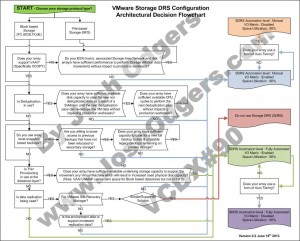I have had a large response to my earlier example vNetworking design with 4 x 10GB NICs, and I have been asked, “What if I only have 2 x 10GB NICs”, so the below is an example of an environment which was limited to just two (2) x 10GB NICs and used IP Storage.
If your environment uses FC/FCoE storage, the below still applies and the IP storage components can simply be ignored.
Requirements
1. Provide high performance and redundant access to the IP Storage (if required)
2. Ensure ESXi hosts could be evacuated in a timely manner for maintenance
3. Prevent significant impact to storage performance by vMotion / Fault Tolerance and Virtual machines traffic
4. Ensure high availability for all network traffic
Constraints
1. Two (2) x 10GB NICs
Solution
Use one dvSwitch to support all VMKernel and virtual machine network traffic and use “Route based of Physical NIC Load” (commonly refereed to as “Load Based teaming”).
Use Network I/O control to ensure in the event of contention that all traffic get appropriate network resources.
Configure the following Network Share Values
IP Storage traffic : 100
ESXi Management: 25
vMotion: 25
Fault Tolerance : 25
Virtual Machine traffic : 50
Configure two (2) VMKernel’s for IP Storage and set each on a different VLAN and Subnet.
Configure VMKernels for vMotion (or Multi-NIC vMotion), ESXi Management and Fault Tolerance and set to active on both 10GB interfaces (default configuration).
All dvPortGroups for Virtual machine traffic (in this example VLANs 6 through 8) will be active on both interfaces.
The above utilizes LBT to load balance network traffic which will dynamically move workload between the two 10GB NICs once one or both network adapters reach >=75% utilization.

Conclusion
Even when your ESXi hosts only have two x 10Gb interfaces, VMware provides enterprise grade features to ensure all traffic (including IP Storage) can get access to sufficient bandwidth to continue serving production workloads until the contention subsides.
This design ensures that in the event a host needs to be evacuated, even during production hours, that it will complete in the fastest possible time with minimal or no impact to production. The faster your vMotion activity completes, the sooner DRS can get your cluster running as smoothly as possible, and in the event you are patching, the sooner your maintenance can be completed and the hosts being patched are returned to the cluster to serve your VMs.
Related Posts
1. Example Architectural Decision – Network I/O Control for ESXi Host using IP Storage (4 x 10 GB NICs)
2. Network I/O Control Shares/Limits for ESXi Host using IP Storage


